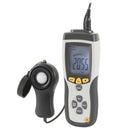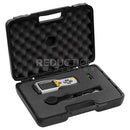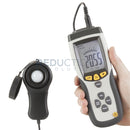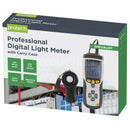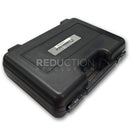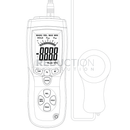Protech Light Meter Pro With Case
This Light Meter allows you to measure lighting intensity from 0 to 400,000 Lux and features:
- Easy to read display screen.
- Sensor cover, hard carry case, battery, and printed instruction manual included.
- Used to assess the real-world performance of LED lights, natural light levels in buildings or the completion of energy audits.
What are Lux, Foot Candles, and Lumens?
This light meter accurately displays light levels in terms of Lux (lx) and Foot Candles (fc). These are both measures of lighting intensity.
- Lux = number of lumens per square metre.
- Foot Candles = number of lumens per square foot.
Lumens are the SI unit of luminous flux. LED light bulbs and fittings have a specified total lumen output - but this is not something you can directly measure. Instead, you can use this light meter to measure lux at a specific location or distance from that light source.

Professional 400K Lux Meter with Carry Case.
Factory Calibration
This lux meter is factory calibrated which means you can use it as-is out of the box. It does not come with a calibration certificate, which may be required for some higher end work.
Use this Lux Meter to identify wasteful lighting & save energy
To provide just one example, hallway and corridor lighting is often much brighter than needed. This results in wasted energy in most buildings.
The Australian Standard for interior and workplace lighting (AS/NZS 1680) outlines recommended lighting levels for a range of tasks. These are summarised in the table below for your reference.
Specifications - Pro Lux Light Meter With Case
| Measurements |
Lux (lx) or foot-candle (fc) |
| Range |
0 - 400,000 lux |
| Resolution | 0.1 lux |
| Accuracy | ±5% (10,000 lux) |
| Compatibility | Indoor and outdoor environments (including direct sunlight) and LED light sources. |
| Sample Rate |
1.5 per second |
| Modes | Max/Min, Data hold, Relative, Auto Zeroing |
| Display | 4 digit backlit, 30min auto shut-off |
| Sensor |
Silicon photo-diode |
| Battery | 9V battery (included) |
| Dimensions | Main unit - 20.3 x 7.5 x 5.0mm (H x W x D) |
| Weight | 280 grams |
| Product Identifiers | QM1584 |
| Further Details | User Manual (PDF). |
| Warranty | 2 Years |
Australian Standards Recommended Lux Levels
The following information is a summary of Table 3.1 in AS/NZS 1680.2.2 – Interior and workplace lighting. Use the lux meter to check actual lighting levels in your workplace against these recommendations. 'Lux' column = recommended illumination.
| Area | Examples | Lux |
| Interiors rarely visited where lighting is only required to aid movement and orientation | Passing through corridors and walkways | 40 |
| Areas of intermittent use for tasks of coarse detail | Movement, orientation and tasks of coarse detail in areas such as change rooms, storage rooms, loading bays etc. | 80 |
| Areas that are continually used for tasks of coarse detail | Simple tasks such as occasional reading of clearly printed documents for short periods or rough bench or machine work in areas such as waiting rooms and entrance halls etc. | 160 |
| Continuously occupied interiors used for ordinary tasks with high contrasts or large detail | Food preparation areas; counters for transactions; school boards; medium woodworking | 240 |
| Areas where visual tasks are moderately difficult and include moderate detail or have lower contrasts | Routine office tasks such as reading, typing and writing in office spaces or enquiry desks | 320 |
| Areas where visual tasks are moderately difficult and include moderate detail and have lower contrasts | Medium level inspection work such as fine woodwork or car assembly | 400 |
| Areas where visual tasks are difficult are detailed or of low contrast | Visually difficult tasks including most inspection tasks such as proofreading, fine machine work or fine painting | 600 |
| Areas where visual tasks involve very small detail and very low contrast | Very difficult tasks such as fine inspection, paint retouching or fine manufacture | 800 |
| Areas where visual work is extremely difficult with extremely small detail or with very low contrasts | Extremely difficult tasks that may require visual aids such as graphic arts inspection; hand tailoring; inspection of dark goods; extra-fine bench work etc. | 1200 |
| Areas where visual work is exceptionally difficult with exceptionally small detail and contrast | Exceptionally difficult tasks where visual aids would be of advantage such as the assembly of minute mechanisms and jewellery and watchmaking etc. | 1600 |







